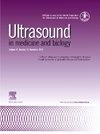A Bi-modal Temporal Segmentation Network for Automated Segmentation of Focal Liver Lesions in Dynamic Contrast-enhanced Ultrasound
IF 2.4
3区 医学
Q2 ACOUSTICS
引用次数: 0
Abstract
Objective
To develop and validate an automated deep learning-based model for focal liver lesion (FLL) segmentation in a dynamic contrast-enhanced ultrasound (CEUS) video.
Methods
In this multi-center and retrospective study, patients with FLL who underwent dynamic CEUS exam were included from September 2021 to December 2021 (model development and internal test sets), and from March 2023 to May 2023 (external test sets). A bi-modal temporal segmentation network (BTS-Net) was developed and its performance was evaluated using Dice score, intersection over union (IoU) and Hausdorff distance, and compared against several segmentation methods. Time-intensity curves (TICs) were obtained automatically from BTS-Net and manually de-lineated by an experienced radiologist, and evaluated by intra-class correlation and Pearson correlation co-efficients. Multiple characteristics were analyzed to evaluate the influencing factors of BTS-Net.
Results
A total of 232 patients (160 men, median age 56 y) with single FLL were enrolled. BTS-Net achieved mean Dice scores of 0.78, 0.74 and 0.80, mean IoUs of 0.67, 0.62 and 0.68, and mean Hausdorff distances of 15.83, 16.01 and 15.04 in the internal test set and two external test sets, respectively. The mean intra-class correlation and Pearson correlation co-efficients of TIC were 0.89, 0.92 and 0.98, and 0.91, 0.93 and 0.99, respectively. BTS-Net demonstrated a significantly higher mean Dice score and IoU in large (0.82, 0.72), homogeneous positive enhanced (0.81, 0.70) or stable (0.81, 0.70) lesions in pooled test sets.
Conclusion
Our study proposed BTS-Net for automated FLL segmentation of dynamic CEUS video, achieving favorable performance in the test sets. Downstream TIC generation based on BTS-Net performed well, demonstrating its potential as an effective segmentation tool in clinical practice.
一种用于动态增强超声肝局灶性病变自动分割的双模态时间分割网络。
目的:开发并验证基于深度学习的动态超声(CEUS)视频局灶性肝脏病变(FLL)自动分割模型。方法:在这项多中心回顾性研究中,纳入了2021年9月至2021年12月(模型开发和内部测试集)和2023年3月至2023年5月(外部测试集)接受动态超声造影检查的FLL患者。提出了一种双模态时间分割网络(BTS-Net),利用Dice评分、IoU和Hausdorff距离对其性能进行了评价,并与几种分割方法进行了比较。时间-强度曲线(tic)由BTS-Net自动获取,由经验丰富的放射科医生手工划线,并通过类内相关和Pearson相关系数进行评估。分析了BTS-Net的多种特性,评价了其影响因素。结果:共有232例患者(160名男性,中位年龄56岁)入组。BTS-Net在内部测试集和两个外部测试集的平均Dice得分分别为0.78、0.74和0.80,平均IoUs分别为0.67、0.62和0.68,平均Hausdorff距离分别为15.83、16.01和15.04。TIC的平均类内相关系数为0.89、0.92和0.98,Pearson相关系数为0.91、0.93和0.99。在合并测试集中,BTS-Net在大(0.82,0.72)、均匀阳性增强(0.81,0.70)或稳定(0.81,0.70)病变中显示出更高的平均Dice评分和IoU。结论:我们的研究提出了BTS-Net用于动态CEUS视频的自动FLL分割,在测试集中取得了良好的性能。基于BTS-Net的下游TIC生成表现良好,显示了其在临床实践中作为有效分割工具的潜力。
本文章由计算机程序翻译,如有差异,请以英文原文为准。
求助全文
约1分钟内获得全文
求助全文
来源期刊
CiteScore
6.20
自引率
6.90%
发文量
325
审稿时长
70 days
期刊介绍:
Ultrasound in Medicine and Biology is the official journal of the World Federation for Ultrasound in Medicine and Biology. The journal publishes original contributions that demonstrate a novel application of an existing ultrasound technology in clinical diagnostic, interventional and therapeutic applications, new and improved clinical techniques, the physics, engineering and technology of ultrasound in medicine and biology, and the interactions between ultrasound and biological systems, including bioeffects. Papers that simply utilize standard diagnostic ultrasound as a measuring tool will be considered out of scope. Extended critical reviews of subjects of contemporary interest in the field are also published, in addition to occasional editorial articles, clinical and technical notes, book reviews, letters to the editor and a calendar of forthcoming meetings. It is the aim of the journal fully to meet the information and publication requirements of the clinicians, scientists, engineers and other professionals who constitute the biomedical ultrasonic community.

 求助内容:
求助内容: 应助结果提醒方式:
应助结果提醒方式:


